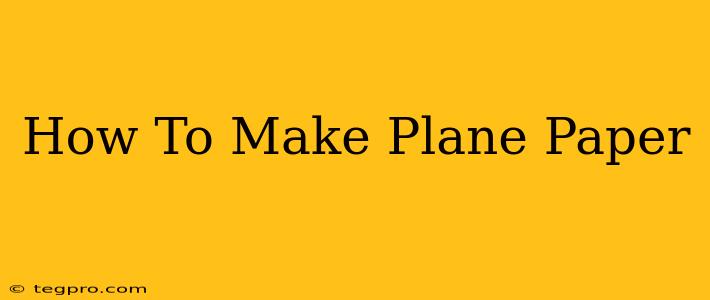Want to learn how to make paper airplanes that soar? This comprehensive guide will take you from simple designs to more advanced models, covering everything you need to know to become a paper airplane pro. Whether you're a kid looking for a fun activity or an adult seeking a nostalgic pastime, we've got you covered!
Choosing Your Paper: The Foundation of Flight
The type of paper you choose significantly impacts your airplane's performance. Avoid flimsy paper; it will crumple easily and won't fly well. Here's a breakdown:
Best Paper Choices:
- Printer Paper: A readily available and reliable option. The standard weight provides a good balance of strength and flexibility.
- Construction Paper: Slightly thicker than printer paper, construction paper can create more robust airplanes, particularly helpful for younger children.
- Lightweight Cardstock: For experienced builders, lightweight cardstock offers a great combination of durability and aerodynamic properties, leading to longer flights.
Papers to Avoid:
- Newspaper: Too flimsy and prone to tearing.
- Magazine Paper: Glossy finishes and varying thicknesses make it difficult to fold consistently.
Simple Paper Airplane Designs: Perfect for Beginners
Let's start with some easy-to-make designs ideal for newcomers to the art of paper airplane construction:
The Classic Dart:
This is arguably the most well-known paper airplane design. Its simple construction allows even young children to build it with ease. Search online for "classic dart paper airplane instructions" for a detailed tutorial with diagrams. Focus on sharp creases for optimal flight.
The Simple Glider:
Another beginner-friendly design, the simple glider prioritizes stability over speed. Its wide wings and relatively flat design make it perfect for practicing gentle gliding techniques. Again, a quick online search will provide clear instructions with illustrations.
Advanced Paper Airplane Designs: Challenge Yourself!
Once you've mastered the basics, it's time to tackle some more complex designs. These require more precision in folding and often incorporate unique aerodynamic features for enhanced performance.
The Advanced Dart:
This design builds upon the classic dart, incorporating additional folds and flaps to improve control and distance. Look for tutorials focusing on "advanced dart paper airplane" to unlock its secrets.
The Boomerang Airplane:
This exciting design attempts to mimic the flight of a boomerang, returning to the thrower after a brief flight. Its construction is more intricate, requiring careful attention to detail. Search for "how to make a boomerang airplane" to learn this skill.
Tips for Achieving Optimal Flight
No matter which design you choose, these tips will help you maximize your airplane's flight performance:
- Sharp Creases: Ensure all folds are crisp and defined. Use your fingernail or a bone folder to make clean, sharp creases.
- Symmetrical Folding: Accuracy is key. Pay close attention to ensure both sides of your airplane are symmetrical.
- Proper Throwing Technique: Hold the plane firmly, launch it smoothly with an overhand throw, and maintain a slight upward angle.
- Experimentation: Don't be afraid to tweak designs and experiment with different paper types to see how it affects flight characteristics.
Beyond the Basics: The World of Paper Airplane Design
The world of paper airplane design is vast and varied. There are countless designs, each with its own unique characteristics and flight patterns. Online communities and forums dedicated to paper airplane enthusiasts are a great place to find new ideas, designs, and tips for improving your skills.
With practice and patience, you’ll be amazed at the distance and flight patterns you can achieve. So grab some paper, follow these instructions, and get ready to take to the skies! Happy flying!

